Organizational Behaviour and Performance: Job Design & Motivation
VerifiedAdded on 2020/05/16
|7
|2290
|152
Essay
AI Summary
This essay delves into the multifaceted aspects of organizational behavior and its impact on employee performance. It meticulously examines how job design, encompassing task structure and employee needs, significantly influences individual efficiency and satisfaction. The essay explores the importance of a conducive working environment, encompassing technical, human, and organizational elements, in fostering productivity. It analyzes the role of motivation, including Herzberg's two-factor theory and goal-setting principles, in driving superior performance. Furthermore, the essay discusses the significance of both intrinsic and extrinsic rewards, such as recognition, promotion opportunities, and performance-based incentives, in enhancing employee engagement and productivity. By integrating various theories and practical examples, the essay provides a comprehensive understanding of the factors that contribute to organizational excellence.
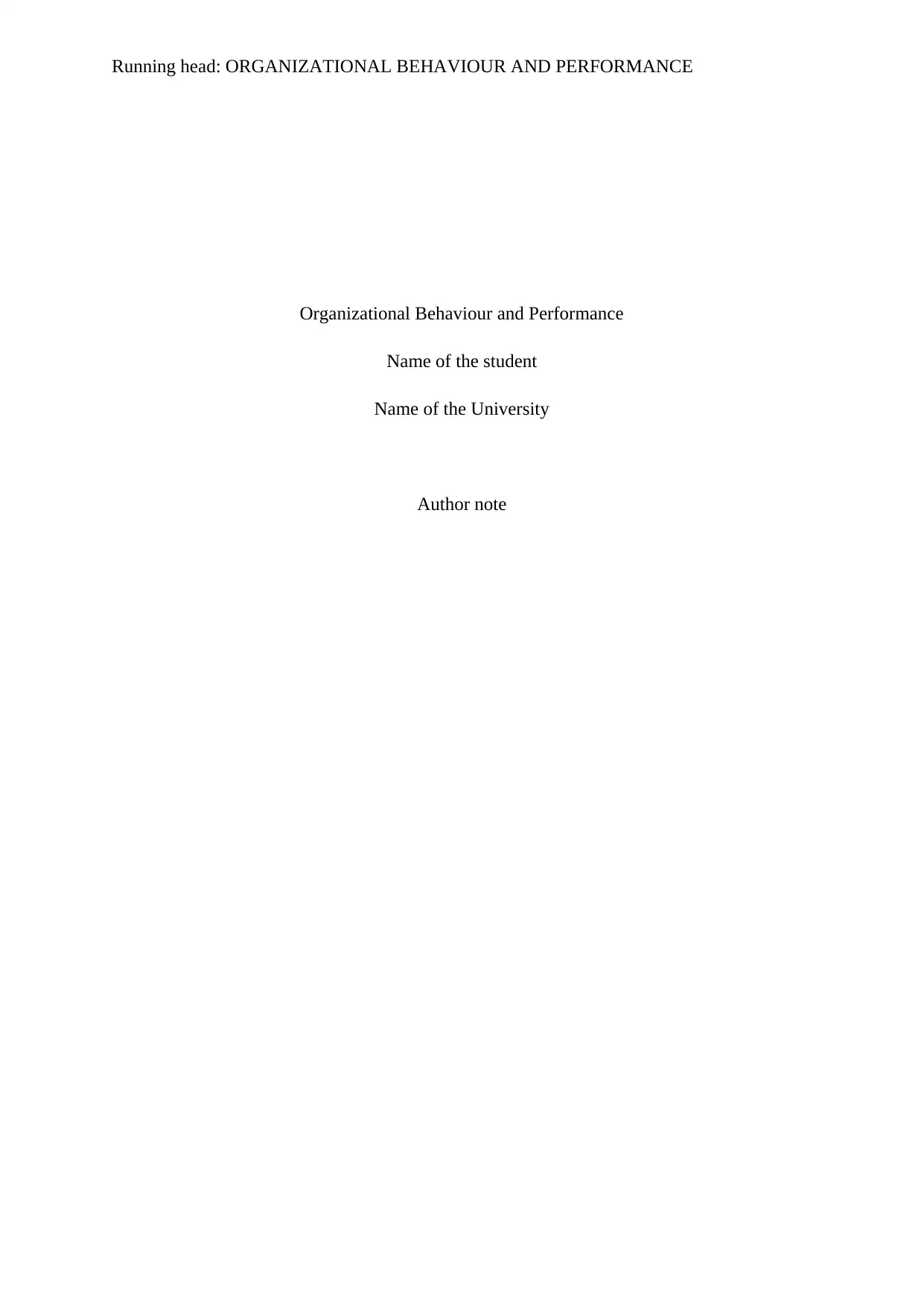
Running head: ORGANIZATIONAL BEHAVIOUR AND PERFORMANCE
Organizational Behaviour and Performance
Name of the student
Name of the University
Author note
Organizational Behaviour and Performance
Name of the student
Name of the University
Author note
Paraphrase This Document
Need a fresh take? Get an instant paraphrase of this document with our AI Paraphraser
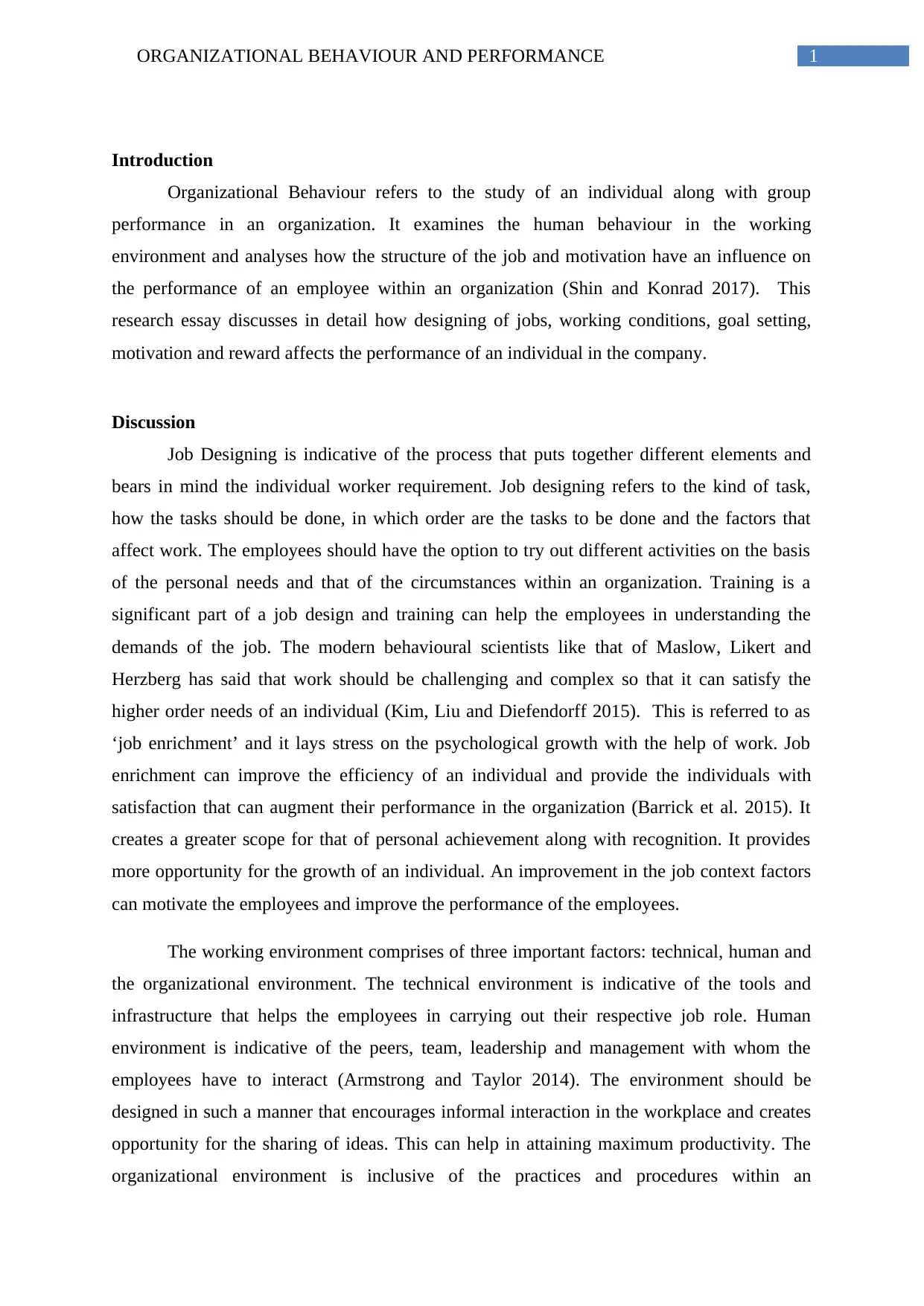
1ORGANIZATIONAL BEHAVIOUR AND PERFORMANCE
Introduction
Organizational Behaviour refers to the study of an individual along with group
performance in an organization. It examines the human behaviour in the working
environment and analyses how the structure of the job and motivation have an influence on
the performance of an employee within an organization (Shin and Konrad 2017). This
research essay discusses in detail how designing of jobs, working conditions, goal setting,
motivation and reward affects the performance of an individual in the company.
Discussion
Job Designing is indicative of the process that puts together different elements and
bears in mind the individual worker requirement. Job designing refers to the kind of task,
how the tasks should be done, in which order are the tasks to be done and the factors that
affect work. The employees should have the option to try out different activities on the basis
of the personal needs and that of the circumstances within an organization. Training is a
significant part of a job design and training can help the employees in understanding the
demands of the job. The modern behavioural scientists like that of Maslow, Likert and
Herzberg has said that work should be challenging and complex so that it can satisfy the
higher order needs of an individual (Kim, Liu and Diefendorff 2015). This is referred to as
‘job enrichment’ and it lays stress on the psychological growth with the help of work. Job
enrichment can improve the efficiency of an individual and provide the individuals with
satisfaction that can augment their performance in the organization (Barrick et al. 2015). It
creates a greater scope for that of personal achievement along with recognition. It provides
more opportunity for the growth of an individual. An improvement in the job context factors
can motivate the employees and improve the performance of the employees.
The working environment comprises of three important factors: technical, human and
the organizational environment. The technical environment is indicative of the tools and
infrastructure that helps the employees in carrying out their respective job role. Human
environment is indicative of the peers, team, leadership and management with whom the
employees have to interact (Armstrong and Taylor 2014). The environment should be
designed in such a manner that encourages informal interaction in the workplace and creates
opportunity for the sharing of ideas. This can help in attaining maximum productivity. The
organizational environment is inclusive of the practices and procedures within an
Introduction
Organizational Behaviour refers to the study of an individual along with group
performance in an organization. It examines the human behaviour in the working
environment and analyses how the structure of the job and motivation have an influence on
the performance of an employee within an organization (Shin and Konrad 2017). This
research essay discusses in detail how designing of jobs, working conditions, goal setting,
motivation and reward affects the performance of an individual in the company.
Discussion
Job Designing is indicative of the process that puts together different elements and
bears in mind the individual worker requirement. Job designing refers to the kind of task,
how the tasks should be done, in which order are the tasks to be done and the factors that
affect work. The employees should have the option to try out different activities on the basis
of the personal needs and that of the circumstances within an organization. Training is a
significant part of a job design and training can help the employees in understanding the
demands of the job. The modern behavioural scientists like that of Maslow, Likert and
Herzberg has said that work should be challenging and complex so that it can satisfy the
higher order needs of an individual (Kim, Liu and Diefendorff 2015). This is referred to as
‘job enrichment’ and it lays stress on the psychological growth with the help of work. Job
enrichment can improve the efficiency of an individual and provide the individuals with
satisfaction that can augment their performance in the organization (Barrick et al. 2015). It
creates a greater scope for that of personal achievement along with recognition. It provides
more opportunity for the growth of an individual. An improvement in the job context factors
can motivate the employees and improve the performance of the employees.
The working environment comprises of three important factors: technical, human and
the organizational environment. The technical environment is indicative of the tools and
infrastructure that helps the employees in carrying out their respective job role. Human
environment is indicative of the peers, team, leadership and management with whom the
employees have to interact (Armstrong and Taylor 2014). The environment should be
designed in such a manner that encourages informal interaction in the workplace and creates
opportunity for the sharing of ideas. This can help in attaining maximum productivity. The
organizational environment is inclusive of the practices and procedures within an
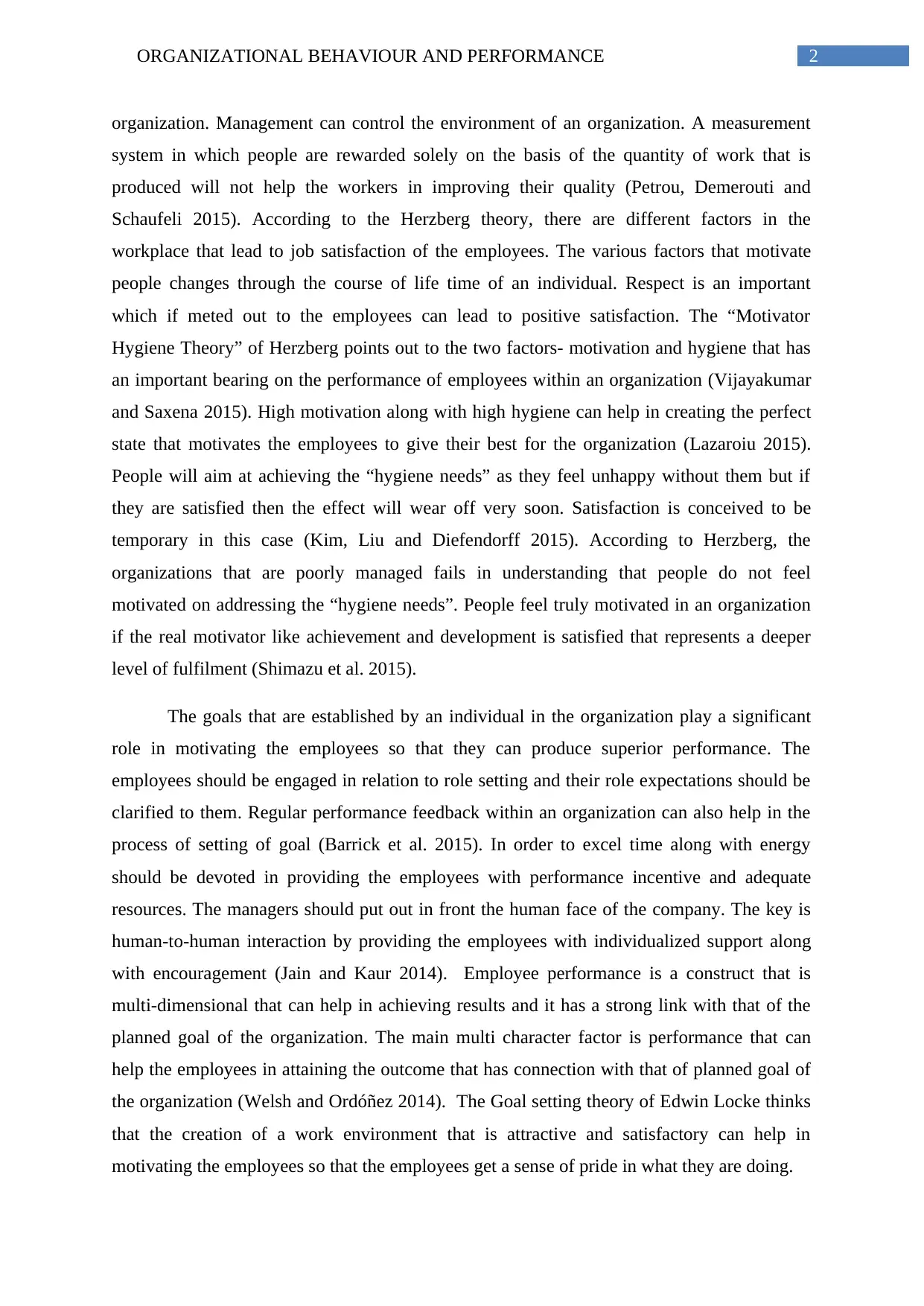
2ORGANIZATIONAL BEHAVIOUR AND PERFORMANCE
organization. Management can control the environment of an organization. A measurement
system in which people are rewarded solely on the basis of the quantity of work that is
produced will not help the workers in improving their quality (Petrou, Demerouti and
Schaufeli 2015). According to the Herzberg theory, there are different factors in the
workplace that lead to job satisfaction of the employees. The various factors that motivate
people changes through the course of life time of an individual. Respect is an important
which if meted out to the employees can lead to positive satisfaction. The “Motivator
Hygiene Theory” of Herzberg points out to the two factors- motivation and hygiene that has
an important bearing on the performance of employees within an organization (Vijayakumar
and Saxena 2015). High motivation along with high hygiene can help in creating the perfect
state that motivates the employees to give their best for the organization (Lazaroiu 2015).
People will aim at achieving the “hygiene needs” as they feel unhappy without them but if
they are satisfied then the effect will wear off very soon. Satisfaction is conceived to be
temporary in this case (Kim, Liu and Diefendorff 2015). According to Herzberg, the
organizations that are poorly managed fails in understanding that people do not feel
motivated on addressing the “hygiene needs”. People feel truly motivated in an organization
if the real motivator like achievement and development is satisfied that represents a deeper
level of fulfilment (Shimazu et al. 2015).
The goals that are established by an individual in the organization play a significant
role in motivating the employees so that they can produce superior performance. The
employees should be engaged in relation to role setting and their role expectations should be
clarified to them. Regular performance feedback within an organization can also help in the
process of setting of goal (Barrick et al. 2015). In order to excel time along with energy
should be devoted in providing the employees with performance incentive and adequate
resources. The managers should put out in front the human face of the company. The key is
human-to-human interaction by providing the employees with individualized support along
with encouragement (Jain and Kaur 2014). Employee performance is a construct that is
multi-dimensional that can help in achieving results and it has a strong link with that of the
planned goal of the organization. The main multi character factor is performance that can
help the employees in attaining the outcome that has connection with that of planned goal of
the organization (Welsh and Ordóñez 2014). The Goal setting theory of Edwin Locke thinks
that the creation of a work environment that is attractive and satisfactory can help in
motivating the employees so that the employees get a sense of pride in what they are doing.
organization. Management can control the environment of an organization. A measurement
system in which people are rewarded solely on the basis of the quantity of work that is
produced will not help the workers in improving their quality (Petrou, Demerouti and
Schaufeli 2015). According to the Herzberg theory, there are different factors in the
workplace that lead to job satisfaction of the employees. The various factors that motivate
people changes through the course of life time of an individual. Respect is an important
which if meted out to the employees can lead to positive satisfaction. The “Motivator
Hygiene Theory” of Herzberg points out to the two factors- motivation and hygiene that has
an important bearing on the performance of employees within an organization (Vijayakumar
and Saxena 2015). High motivation along with high hygiene can help in creating the perfect
state that motivates the employees to give their best for the organization (Lazaroiu 2015).
People will aim at achieving the “hygiene needs” as they feel unhappy without them but if
they are satisfied then the effect will wear off very soon. Satisfaction is conceived to be
temporary in this case (Kim, Liu and Diefendorff 2015). According to Herzberg, the
organizations that are poorly managed fails in understanding that people do not feel
motivated on addressing the “hygiene needs”. People feel truly motivated in an organization
if the real motivator like achievement and development is satisfied that represents a deeper
level of fulfilment (Shimazu et al. 2015).
The goals that are established by an individual in the organization play a significant
role in motivating the employees so that they can produce superior performance. The
employees should be engaged in relation to role setting and their role expectations should be
clarified to them. Regular performance feedback within an organization can also help in the
process of setting of goal (Barrick et al. 2015). In order to excel time along with energy
should be devoted in providing the employees with performance incentive and adequate
resources. The managers should put out in front the human face of the company. The key is
human-to-human interaction by providing the employees with individualized support along
with encouragement (Jain and Kaur 2014). Employee performance is a construct that is
multi-dimensional that can help in achieving results and it has a strong link with that of the
planned goal of the organization. The main multi character factor is performance that can
help the employees in attaining the outcome that has connection with that of planned goal of
the organization (Welsh and Ordóñez 2014). The Goal setting theory of Edwin Locke thinks
that the creation of a work environment that is attractive and satisfactory can help in
motivating the employees so that the employees get a sense of pride in what they are doing.
⊘ This is a preview!⊘
Do you want full access?
Subscribe today to unlock all pages.

Trusted by 1+ million students worldwide
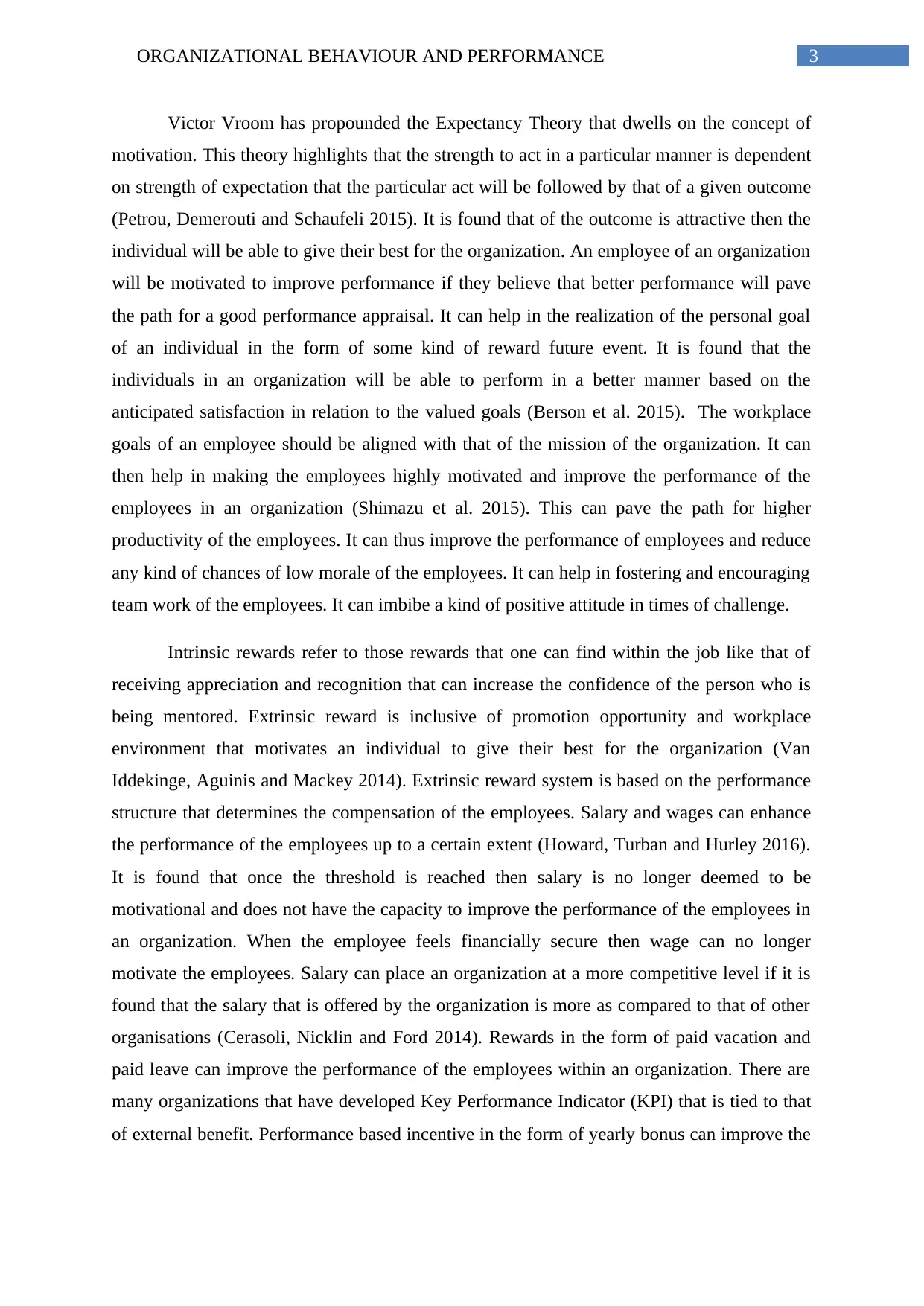
3ORGANIZATIONAL BEHAVIOUR AND PERFORMANCE
Victor Vroom has propounded the Expectancy Theory that dwells on the concept of
motivation. This theory highlights that the strength to act in a particular manner is dependent
on strength of expectation that the particular act will be followed by that of a given outcome
(Petrou, Demerouti and Schaufeli 2015). It is found that of the outcome is attractive then the
individual will be able to give their best for the organization. An employee of an organization
will be motivated to improve performance if they believe that better performance will pave
the path for a good performance appraisal. It can help in the realization of the personal goal
of an individual in the form of some kind of reward future event. It is found that the
individuals in an organization will be able to perform in a better manner based on the
anticipated satisfaction in relation to the valued goals (Berson et al. 2015). The workplace
goals of an employee should be aligned with that of the mission of the organization. It can
then help in making the employees highly motivated and improve the performance of the
employees in an organization (Shimazu et al. 2015). This can pave the path for higher
productivity of the employees. It can thus improve the performance of employees and reduce
any kind of chances of low morale of the employees. It can help in fostering and encouraging
team work of the employees. It can imbibe a kind of positive attitude in times of challenge.
Intrinsic rewards refer to those rewards that one can find within the job like that of
receiving appreciation and recognition that can increase the confidence of the person who is
being mentored. Extrinsic reward is inclusive of promotion opportunity and workplace
environment that motivates an individual to give their best for the organization (Van
Iddekinge, Aguinis and Mackey 2014). Extrinsic reward system is based on the performance
structure that determines the compensation of the employees. Salary and wages can enhance
the performance of the employees up to a certain extent (Howard, Turban and Hurley 2016).
It is found that once the threshold is reached then salary is no longer deemed to be
motivational and does not have the capacity to improve the performance of the employees in
an organization. When the employee feels financially secure then wage can no longer
motivate the employees. Salary can place an organization at a more competitive level if it is
found that the salary that is offered by the organization is more as compared to that of other
organisations (Cerasoli, Nicklin and Ford 2014). Rewards in the form of paid vacation and
paid leave can improve the performance of the employees within an organization. There are
many organizations that have developed Key Performance Indicator (KPI) that is tied to that
of external benefit. Performance based incentive in the form of yearly bonus can improve the
Victor Vroom has propounded the Expectancy Theory that dwells on the concept of
motivation. This theory highlights that the strength to act in a particular manner is dependent
on strength of expectation that the particular act will be followed by that of a given outcome
(Petrou, Demerouti and Schaufeli 2015). It is found that of the outcome is attractive then the
individual will be able to give their best for the organization. An employee of an organization
will be motivated to improve performance if they believe that better performance will pave
the path for a good performance appraisal. It can help in the realization of the personal goal
of an individual in the form of some kind of reward future event. It is found that the
individuals in an organization will be able to perform in a better manner based on the
anticipated satisfaction in relation to the valued goals (Berson et al. 2015). The workplace
goals of an employee should be aligned with that of the mission of the organization. It can
then help in making the employees highly motivated and improve the performance of the
employees in an organization (Shimazu et al. 2015). This can pave the path for higher
productivity of the employees. It can thus improve the performance of employees and reduce
any kind of chances of low morale of the employees. It can help in fostering and encouraging
team work of the employees. It can imbibe a kind of positive attitude in times of challenge.
Intrinsic rewards refer to those rewards that one can find within the job like that of
receiving appreciation and recognition that can increase the confidence of the person who is
being mentored. Extrinsic reward is inclusive of promotion opportunity and workplace
environment that motivates an individual to give their best for the organization (Van
Iddekinge, Aguinis and Mackey 2014). Extrinsic reward system is based on the performance
structure that determines the compensation of the employees. Salary and wages can enhance
the performance of the employees up to a certain extent (Howard, Turban and Hurley 2016).
It is found that once the threshold is reached then salary is no longer deemed to be
motivational and does not have the capacity to improve the performance of the employees in
an organization. When the employee feels financially secure then wage can no longer
motivate the employees. Salary can place an organization at a more competitive level if it is
found that the salary that is offered by the organization is more as compared to that of other
organisations (Cerasoli, Nicklin and Ford 2014). Rewards in the form of paid vacation and
paid leave can improve the performance of the employees within an organization. There are
many organizations that have developed Key Performance Indicator (KPI) that is tied to that
of external benefit. Performance based incentive in the form of yearly bonus can improve the
Paraphrase This Document
Need a fresh take? Get an instant paraphrase of this document with our AI Paraphraser
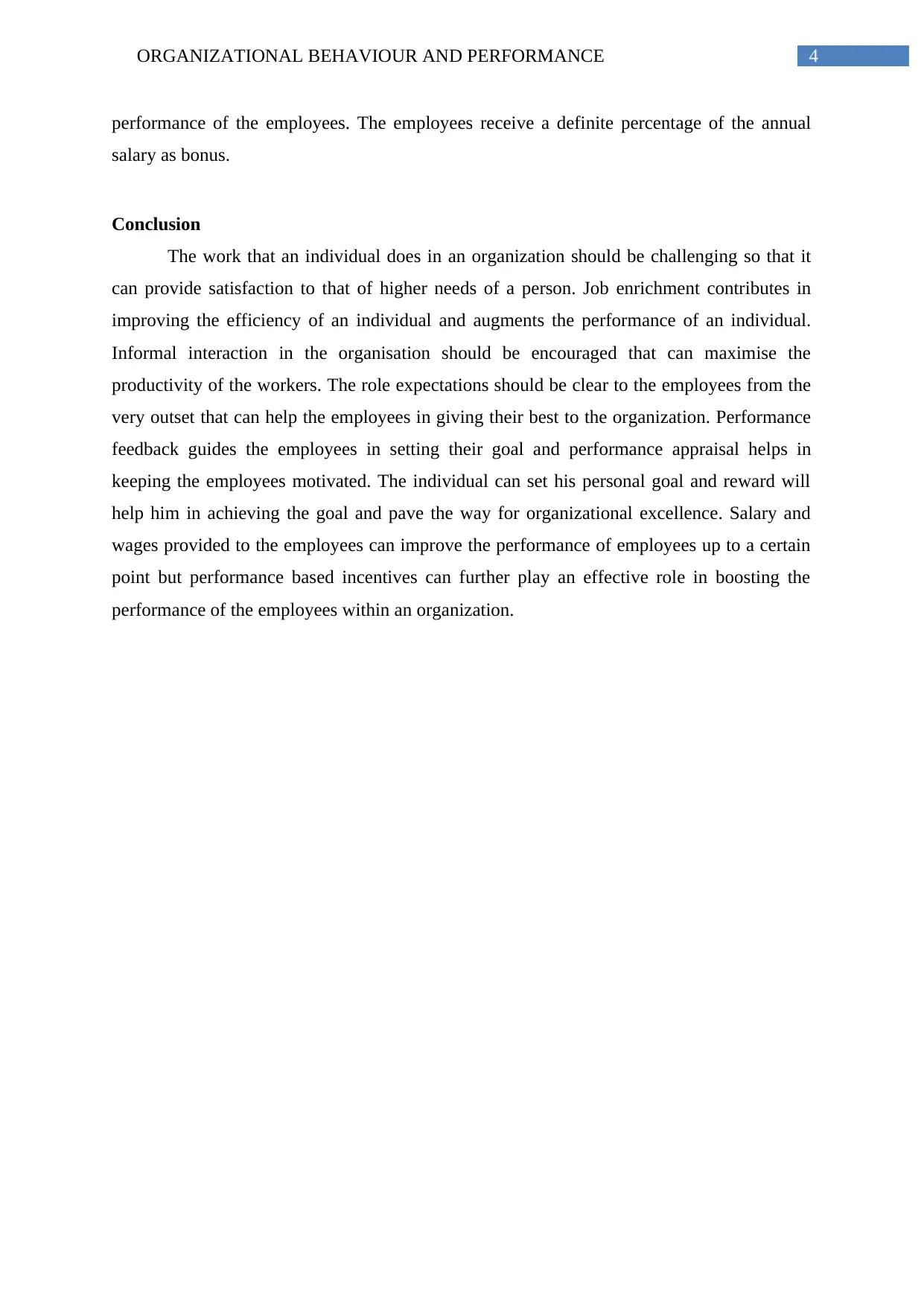
4ORGANIZATIONAL BEHAVIOUR AND PERFORMANCE
performance of the employees. The employees receive a definite percentage of the annual
salary as bonus.
Conclusion
The work that an individual does in an organization should be challenging so that it
can provide satisfaction to that of higher needs of a person. Job enrichment contributes in
improving the efficiency of an individual and augments the performance of an individual.
Informal interaction in the organisation should be encouraged that can maximise the
productivity of the workers. The role expectations should be clear to the employees from the
very outset that can help the employees in giving their best to the organization. Performance
feedback guides the employees in setting their goal and performance appraisal helps in
keeping the employees motivated. The individual can set his personal goal and reward will
help him in achieving the goal and pave the way for organizational excellence. Salary and
wages provided to the employees can improve the performance of employees up to a certain
point but performance based incentives can further play an effective role in boosting the
performance of the employees within an organization.
performance of the employees. The employees receive a definite percentage of the annual
salary as bonus.
Conclusion
The work that an individual does in an organization should be challenging so that it
can provide satisfaction to that of higher needs of a person. Job enrichment contributes in
improving the efficiency of an individual and augments the performance of an individual.
Informal interaction in the organisation should be encouraged that can maximise the
productivity of the workers. The role expectations should be clear to the employees from the
very outset that can help the employees in giving their best to the organization. Performance
feedback guides the employees in setting their goal and performance appraisal helps in
keeping the employees motivated. The individual can set his personal goal and reward will
help him in achieving the goal and pave the way for organizational excellence. Salary and
wages provided to the employees can improve the performance of employees up to a certain
point but performance based incentives can further play an effective role in boosting the
performance of the employees within an organization.
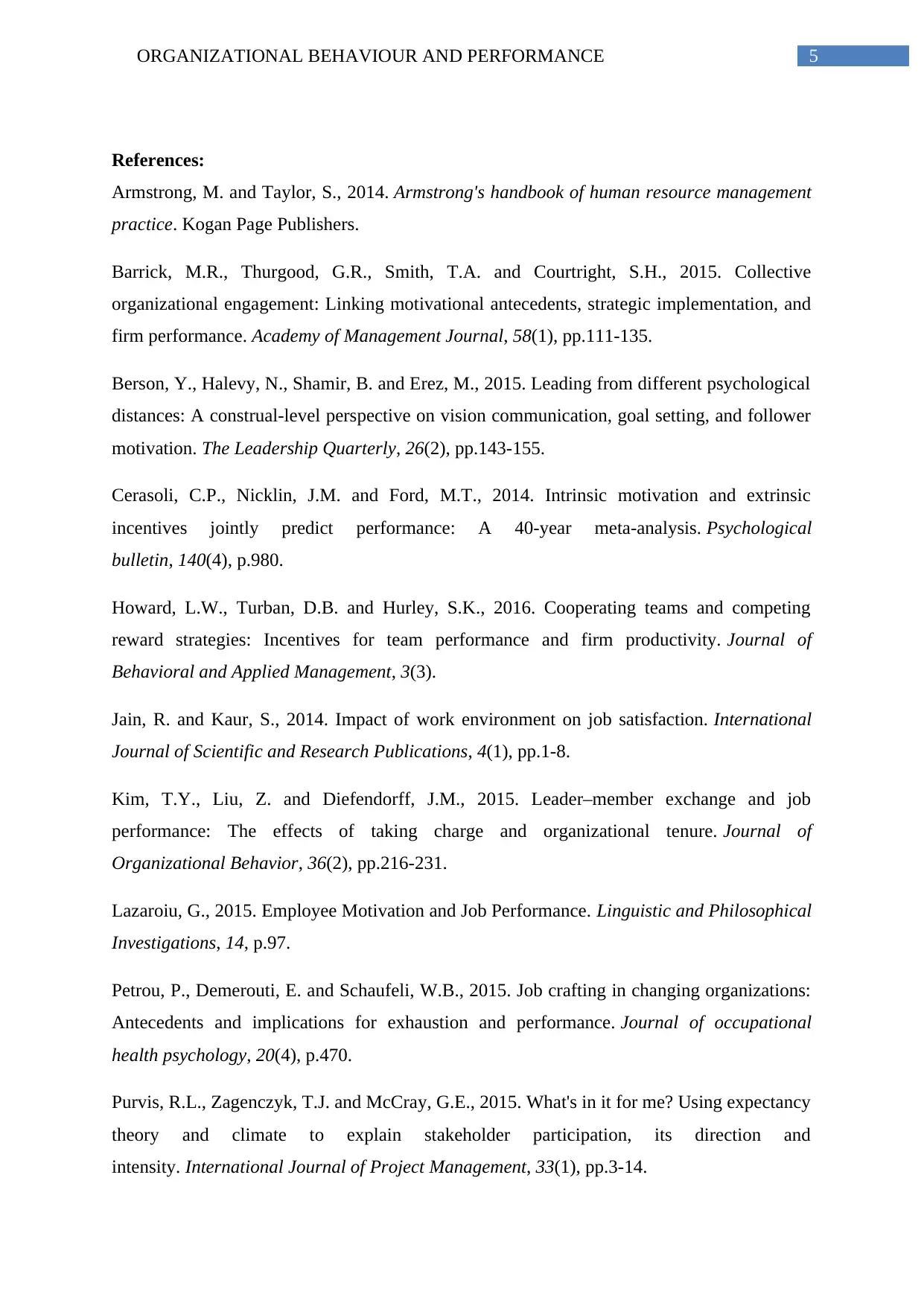
5ORGANIZATIONAL BEHAVIOUR AND PERFORMANCE
References:
Armstrong, M. and Taylor, S., 2014. Armstrong's handbook of human resource management
practice. Kogan Page Publishers.
Barrick, M.R., Thurgood, G.R., Smith, T.A. and Courtright, S.H., 2015. Collective
organizational engagement: Linking motivational antecedents, strategic implementation, and
firm performance. Academy of Management Journal, 58(1), pp.111-135.
Berson, Y., Halevy, N., Shamir, B. and Erez, M., 2015. Leading from different psychological
distances: A construal-level perspective on vision communication, goal setting, and follower
motivation. The Leadership Quarterly, 26(2), pp.143-155.
Cerasoli, C.P., Nicklin, J.M. and Ford, M.T., 2014. Intrinsic motivation and extrinsic
incentives jointly predict performance: A 40-year meta-analysis. Psychological
bulletin, 140(4), p.980.
Howard, L.W., Turban, D.B. and Hurley, S.K., 2016. Cooperating teams and competing
reward strategies: Incentives for team performance and firm productivity. Journal of
Behavioral and Applied Management, 3(3).
Jain, R. and Kaur, S., 2014. Impact of work environment on job satisfaction. International
Journal of Scientific and Research Publications, 4(1), pp.1-8.
Kim, T.Y., Liu, Z. and Diefendorff, J.M., 2015. Leader–member exchange and job
performance: The effects of taking charge and organizational tenure. Journal of
Organizational Behavior, 36(2), pp.216-231.
Lazaroiu, G., 2015. Employee Motivation and Job Performance. Linguistic and Philosophical
Investigations, 14, p.97.
Petrou, P., Demerouti, E. and Schaufeli, W.B., 2015. Job crafting in changing organizations:
Antecedents and implications for exhaustion and performance. Journal of occupational
health psychology, 20(4), p.470.
Purvis, R.L., Zagenczyk, T.J. and McCray, G.E., 2015. What's in it for me? Using expectancy
theory and climate to explain stakeholder participation, its direction and
intensity. International Journal of Project Management, 33(1), pp.3-14.
References:
Armstrong, M. and Taylor, S., 2014. Armstrong's handbook of human resource management
practice. Kogan Page Publishers.
Barrick, M.R., Thurgood, G.R., Smith, T.A. and Courtright, S.H., 2015. Collective
organizational engagement: Linking motivational antecedents, strategic implementation, and
firm performance. Academy of Management Journal, 58(1), pp.111-135.
Berson, Y., Halevy, N., Shamir, B. and Erez, M., 2015. Leading from different psychological
distances: A construal-level perspective on vision communication, goal setting, and follower
motivation. The Leadership Quarterly, 26(2), pp.143-155.
Cerasoli, C.P., Nicklin, J.M. and Ford, M.T., 2014. Intrinsic motivation and extrinsic
incentives jointly predict performance: A 40-year meta-analysis. Psychological
bulletin, 140(4), p.980.
Howard, L.W., Turban, D.B. and Hurley, S.K., 2016. Cooperating teams and competing
reward strategies: Incentives for team performance and firm productivity. Journal of
Behavioral and Applied Management, 3(3).
Jain, R. and Kaur, S., 2014. Impact of work environment on job satisfaction. International
Journal of Scientific and Research Publications, 4(1), pp.1-8.
Kim, T.Y., Liu, Z. and Diefendorff, J.M., 2015. Leader–member exchange and job
performance: The effects of taking charge and organizational tenure. Journal of
Organizational Behavior, 36(2), pp.216-231.
Lazaroiu, G., 2015. Employee Motivation and Job Performance. Linguistic and Philosophical
Investigations, 14, p.97.
Petrou, P., Demerouti, E. and Schaufeli, W.B., 2015. Job crafting in changing organizations:
Antecedents and implications for exhaustion and performance. Journal of occupational
health psychology, 20(4), p.470.
Purvis, R.L., Zagenczyk, T.J. and McCray, G.E., 2015. What's in it for me? Using expectancy
theory and climate to explain stakeholder participation, its direction and
intensity. International Journal of Project Management, 33(1), pp.3-14.
⊘ This is a preview!⊘
Do you want full access?
Subscribe today to unlock all pages.

Trusted by 1+ million students worldwide
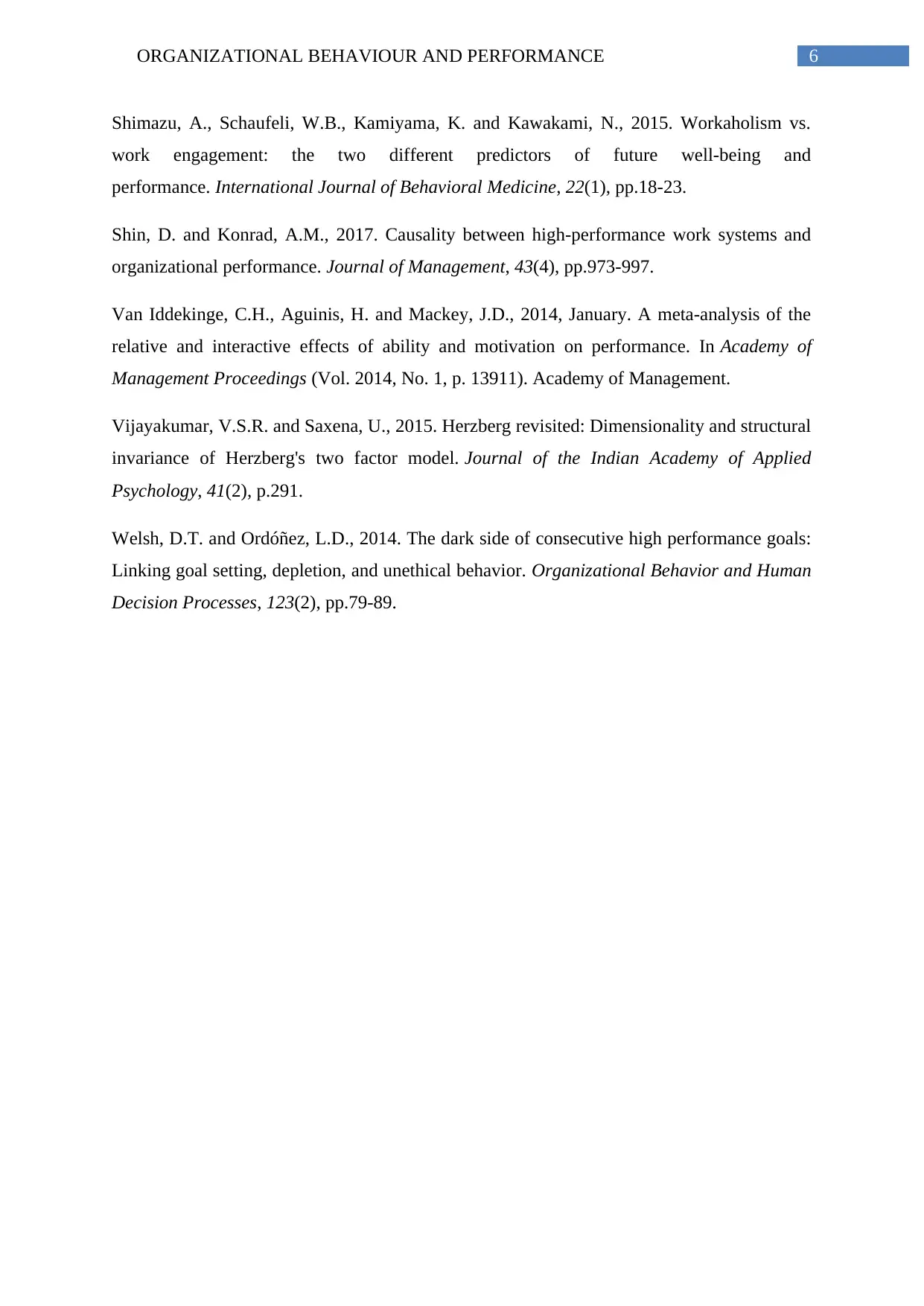
6ORGANIZATIONAL BEHAVIOUR AND PERFORMANCE
Shimazu, A., Schaufeli, W.B., Kamiyama, K. and Kawakami, N., 2015. Workaholism vs.
work engagement: the two different predictors of future well-being and
performance. International Journal of Behavioral Medicine, 22(1), pp.18-23.
Shin, D. and Konrad, A.M., 2017. Causality between high-performance work systems and
organizational performance. Journal of Management, 43(4), pp.973-997.
Van Iddekinge, C.H., Aguinis, H. and Mackey, J.D., 2014, January. A meta-analysis of the
relative and interactive effects of ability and motivation on performance. In Academy of
Management Proceedings (Vol. 2014, No. 1, p. 13911). Academy of Management.
Vijayakumar, V.S.R. and Saxena, U., 2015. Herzberg revisited: Dimensionality and structural
invariance of Herzberg's two factor model. Journal of the Indian Academy of Applied
Psychology, 41(2), p.291.
Welsh, D.T. and Ordóñez, L.D., 2014. The dark side of consecutive high performance goals:
Linking goal setting, depletion, and unethical behavior. Organizational Behavior and Human
Decision Processes, 123(2), pp.79-89.
Shimazu, A., Schaufeli, W.B., Kamiyama, K. and Kawakami, N., 2015. Workaholism vs.
work engagement: the two different predictors of future well-being and
performance. International Journal of Behavioral Medicine, 22(1), pp.18-23.
Shin, D. and Konrad, A.M., 2017. Causality between high-performance work systems and
organizational performance. Journal of Management, 43(4), pp.973-997.
Van Iddekinge, C.H., Aguinis, H. and Mackey, J.D., 2014, January. A meta-analysis of the
relative and interactive effects of ability and motivation on performance. In Academy of
Management Proceedings (Vol. 2014, No. 1, p. 13911). Academy of Management.
Vijayakumar, V.S.R. and Saxena, U., 2015. Herzberg revisited: Dimensionality and structural
invariance of Herzberg's two factor model. Journal of the Indian Academy of Applied
Psychology, 41(2), p.291.
Welsh, D.T. and Ordóñez, L.D., 2014. The dark side of consecutive high performance goals:
Linking goal setting, depletion, and unethical behavior. Organizational Behavior and Human
Decision Processes, 123(2), pp.79-89.
1 out of 7
Related Documents
Your All-in-One AI-Powered Toolkit for Academic Success.
+13062052269
info@desklib.com
Available 24*7 on WhatsApp / Email
![[object Object]](/_next/static/media/star-bottom.7253800d.svg)
Unlock your academic potential
Copyright © 2020–2025 A2Z Services. All Rights Reserved. Developed and managed by ZUCOL.





